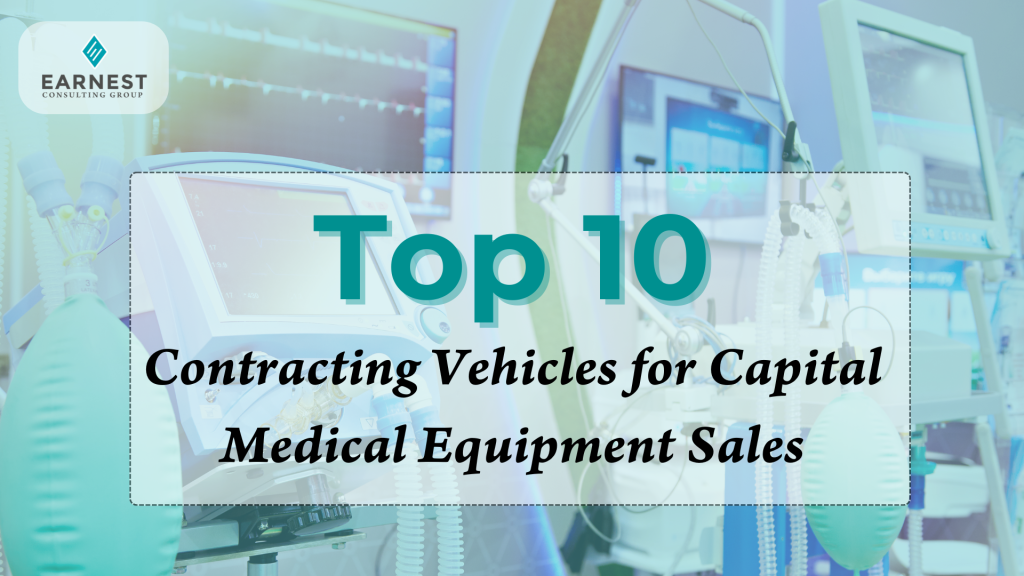The Top 10 Contracting Vehicles for Capital Medical Equipment Sales
January 15, 2025 | Government
In the spirit of David Letterman’s iconic Top Ten Lists, here’s the countdown of the Top 10 Contract Vehicles for Medical Equipment and Product Sales—the means federal agencies use to spend billions on healthcare equipment. Start at #10 and work to the top to see where the big money is spent! The statistics included in this article cover the last five years of contract awards.
10. The Digital Imaging Network – Picture Archiving and Communications System (DIN-PACS)
Total Spent: $163.9 Million
This IDIQ contract supports the acquisition of Picture Archiving and Communications Systems (PACS) for storing, retrieving, and sharing medical imaging.
Key Buyers:
- Department of Veterans Affairs (VA)
- Department of Defense (DoD)
Key Contractors:
- Philips Healthcare Informatics Inc.
9. DLA MSC Patient Monitoring
Total Spent: $203 Million
This IDIQ contract facilitates the purchase of patient monitoring systems, ventilators, and related accessories, ensuring federal healthcare facilities are equipped to handle critical care.
Key Buyers:
- Defense Logistics Agency (DLA) Troop Support Medical
- Department of Health and Human Services
Key Contractors:
- Philips North America LLC
- Karl Storz Endoscopy-America Inc.
- Zoll Medical Corporation
8. Patient Mobility Devices (FSS-65-II-F)
Total Spent: $259 Million
This GSA schedule provides mobility solutions like wheelchairs, scooters, prosthetics, and ramps to enhance veterans’ independence.
Key Buyers:
- Department of Veterans Affairs (VA) Veterans Integrated Service Networks (VISNs)
Key Contractors:
- Permobil Inc.
- Pride Mobility Products Corp.
- Sunrise Medical (US) LLC
7. Critical Analyzers, Laboratory (FSS-66-III)
Total Spent: $262 Million
This FSS covers laboratory equipment, including chemistry analyzers, hematology systems, and immunoassay platforms, vital for clinical testing.
Key Buyers:
- Department of Veterans Affairs (VA) Veterans Integrated Service Networks (VISNs)
Key Contractors:
- Beckman Coulter, Inc.
- Sysmex America, Inc.
- Abbott Laboratories Inc.
6. Medical Surgical Prime Vendor Next Generation (MSPV NG)
Total Spent: $312 Million
This IDIQ vehicle ensures timely delivery of medical and surgical supplies to VA medical centers and other federal facilities.
Key Buyers:
- Department of Veterans Affairs (VA)
- Department of Health and Human Services Indian Health Service
Key Contractors:
- Medline Industries, LP
- Cardinal Health 200, LLC
- American Purchasing Services, LLC
5. Pharmaceuticals and Drugs (FSS-61-IB)
Total Spent: $666 Million
This VA-administered FSS streamlines the procurement of prescription and non-prescription medications, vaccines, and diagnostic agents.
Key Buyers:
- Department of Veterans Affairs (VA)
- Defense Health Agency (DHA)
Key Contractors:
- Merck
- Takeda
- Jazz Pharmaceuticals
4. Positive Airway Pressure Devices and Accessories
Total Spent: $817 Million
This contract vehicle supports CPAP, BiPAP, and VPAP devices and accessories for veterans with sleep apnea.
Key Buyers:
- Department of Veterans Affairs (VA) Veterans Health Administration
- Veterans Integrated Service Networks (VISNs)
Key Contractors:
- First Nation Group LLC
- Medical Place Inc.
3. DLA-VA NAC Radiology and Imaging Systems Program
Total Spent: $917 Million
This program covers radiology and imaging systems like CT scanners, MRI machines, and X-ray systems to modernize federal healthcare facilities.
Key Buyers:
- Department of Veterans Affairs (VA)
- Military treatment centers
Key Contractors:
- GE Precision Healthcare LLC
- Philips North America LLC
2. DLA Medical Capital Equipment Program
Total Spent: $1.43 Billion
This IDIQ vehicle ensures the procurement and maintenance of medical imaging systems such as CT scanners, ultrasound devices, and mammography units.
Key Buyers:
- Department of Veterans Affairs (VA)
- Defense Logistics Agency (DLA)
Key Contractors:
- Siemens Medical Solutions USA, Inc.
- Hologic Sales And Service, LLC
1. Medical Equipment and Supplies (FSS-65-II-A)
Total Spent: $1.75 Billion
Taking the top spot, this FSS covers a broad range of medical equipment, including hospital beds, diagnostic imaging systems, and pharmacy automation.
Key Buyers:
- Department of Veterans Affairs (VA)
- Veterans Integrated Service Networks (VISNs)
Key Contractors:
- Olympus America Inc.
- Hill-Rom, Inc.
- Agiliti Health Inc.
Pro Tip: Research Doesn’t Replace Action
This isn’t just a list—it’s a call to action! Knowing the top contracting vehicles is only valuable if you use the knowledge. So, how are you going to act on it? Whether it’s researching the best vehicle for your products, targeting a new IDIQ contract, or building strategic partnerships, take the next step today and put your research into action.
What are some sales strategies you use with your existing contract vehicles?
« Back to Blog Home




